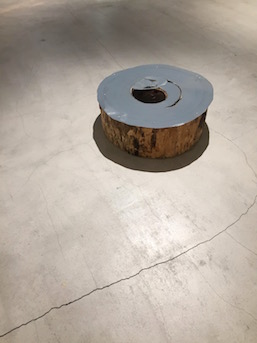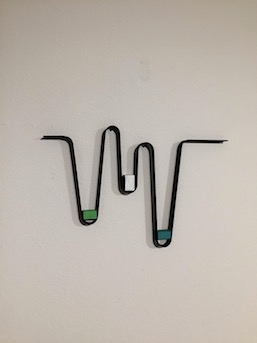Mono-ha in Metal

Suga is known for his involvement in the Mono-ha movement from the 1960s, specifically for taking natural materials and offsetting them with manmade objects and spaces; this approach creates friction and involves the audience as a key component. In the later part of Suga’s career, what is striking is his use of metals to contrast with his signature material, timber. The juxtaposition adds interest to the pieces at The Club as they reflect and shimmer with the gallery lights, lending a mesmerizing element to the space. Works seem to to blend together instead of existing as standalones, one piece leading on to another.
There is a raw unity in this selection of work, which reads surprising coherently as a single body given its lengthy span of time. The visual language here not only involves the tensions of the materials, but also draws out the unique characteristics of the individual pieces. Sheets of metal can look torn, such as in “Marginal Space” (1985), a work with an artificial spiral mimicking the rings on the log beneath it in a wonderfully innocent hand-drawn re-rendering in iron. Suga’s touch can be seen in quite a few works as drafted lines, indicating a future desire to cut there or provide yet another tension as a formal element. Another example appears in “Orientation in Space,” (1983) a roughly painted piece anchored in a visual space while extending into the imagination, as if begging you to unravel it and reveal its other mysteries.
What’s always been exciting about Suga is his unexpected material combinations and gestures. The playfulness apparent in the works of “Released Existence on Edges” encompasses the forms, patterns and rhythms central to their creation. The sense of curiosity and joy in the use of irons and galvanized steels as standalone and composite materials has clearly helped Suga sustain a healthy interest in these materials throughout his career.


Thirty years is a substantial amount of time, and the work – although always unmistakably Suga’s – shifts in its maturity and resolve towards the late 1990s and into the millenium. With pieces such as “Curved Inclination” (1999), there is a rich refinement but equal amounts of tongue-in-cheek and rhythm throughout. The three later works ‘Willow Facing Down’, ‘Split Border (Surroundings of Lake)’ and ‘Composition of Willow’ (all 1998) reach a trifecta of material vs. space vs. viewer, with an extra element of sheen reflecting from the gallery’s lamps onto the concrete floor. Although small in size, “Released Existence on Edges” is an intimate portrait of Suga as an artist, capturing the beautiful breadth of exploration during his “metal period” in its playfulness and maturity.
Simon DeBoer
Simon DeBoer


